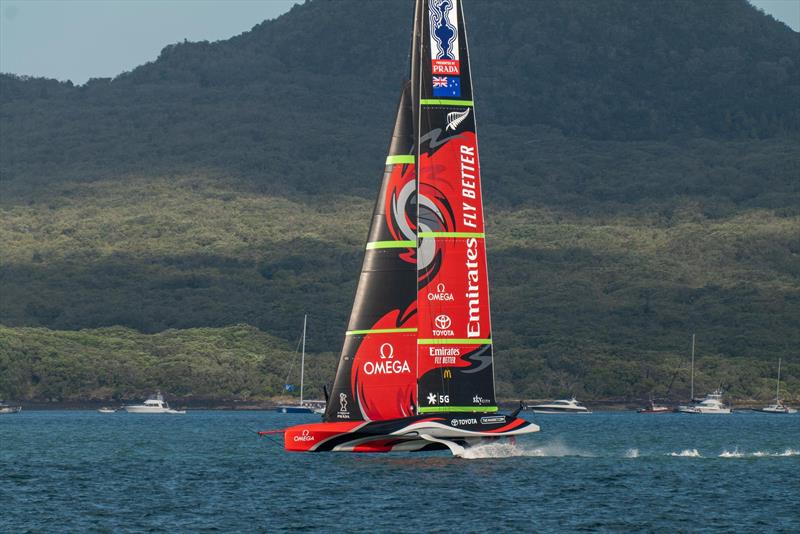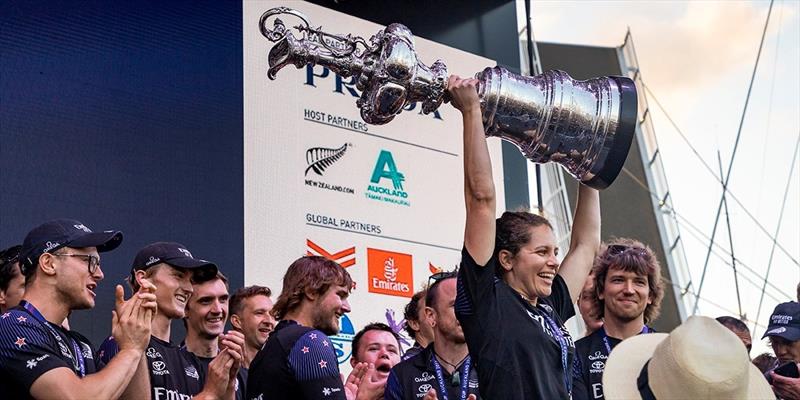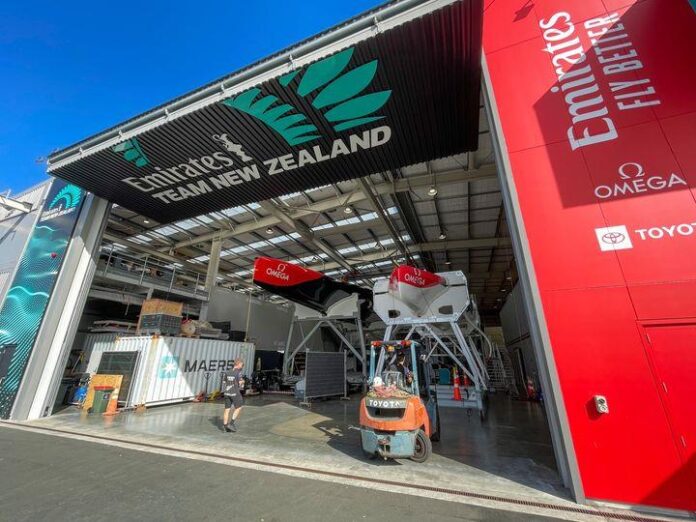Emirates Team New Zealand has followed a predictable path with the “announcement” that the 2021 America’s Cup champion “is back in the shed and will be back out foiling around the harbor with one or two new configurations in due course.”
The expected move was confirmed by the team, with a photo posted on social media with the winning AC75 sitting in the team’s Wynyard Point Base alongside the wingless test boat LEQ12, which has 17 days of test sailing in its logbook.

The announcement follows a familiar path to the 2007, 2013, 2017 and 2021 America’s Cup campaigns, where an effective two-boat program has been run, regardless of the intention of the America’s Cup rules at the time.
In 2007, it was still permitted to build multiple America’s Cup class yachts and run what was known as a two-boat program. In pre-simulator days, it involved months of testing one configuration against another before doing a rinse-and-repeat cycle on the other boat to verify a speed or sailing angle gain.
In 2013, following a change of America’s Cup Class, the team built a full-size AC72 wingsailed catamaran, which was fitted with foils – something not contemplated by the rule-makers, which resulted in complaints to the America’s Jury by the then Defender, Oracle Team USA and the Challenger of Record from Sweden.
Their complaint was dismissed. However, the Kiwis had prematurely revealed their hand, and the other three teams followed suit.
In 2017 Emirates Team NZ found a neat way around the rules by developing a test platform using AC45 hulls but with an almost metre-long rudder gantry, which gave the team the foiling geometry of an AC50 which was the America’s Cup Class for the 2017 Cup in Bermuda.
That move gave the Kiwi team a six-month head start with AC50s on the other teams, which were allowed to launch only one AC50 wingsailed and now foiling catamarans. The Kiwis used the advantage of full-size AC50 components on the test boat, some of which were transferred across to the race boat.
It was a similar story in 2021, following yet another change in America’s Cup Class, two AC75 boats were permitted. Te Aihe (now used as a trial horse by the Alinghi Red Bull Racing team) was developed, with many of the systems transferred across to the raceboat, Te Rehutai, which went on to win the 2021 America’s Cup.
The advantage of transferring tested and developed systems from a development boat across to the race boat is that it saves a lot of debugging and allows teams to put their efforts into developing new gear and systems.
The practice of using a top yacht from the previous Cup as a trial horse stems back to the 1956 America’s Cup, when the Match was sailed in 12 metres, and it is possible, and permitted, to test in full size.
Under the current America’s Cup rules, Emirates Team New Zealand can’t sail Te Rehutai against their AC75 raceboat, but ashore they can sail it against the simulator computer. The latest performance data from Te Rehutai can also be used as input into the AI-based system developed for the 2021 Cup, which will likely be extended.
On the water, they can sail against their LEQ12 development boat, which is a turbo-charged AC40 hull taken out of one-design class configuration.

ETNZ, who designed the AC40, took the option of designing it as a step-on from Te Rehutai, and to some advantage from it being of the same design genre, rather than producing a more radical boat.
The recon team reports that the LEQ12 is nearly as quick despite being almost half the size of an AC75. However, the primary use of Te Rehutai will be to measure its performance data against the Version 1 AC75 configuration to which it was built and then check the gains arising from changes.
The Version 2 of the AC75 class rule has several changes to the Version 1 AC75 used for the 2021 America’s Cup, and Te Rehutai will be a full-sized test bed for some of the Version 2 rule features.
One of the changes will be the testing of the use of cyclors, continuing the work of then-rookie performance engineer Elise Beavis, who was assigned to the secret project soon after she joined the team in 2015 – straight from the University of Auckland with a Bachelor of Engineering degree with First Class Honours.
While cyclors were not illegal in the 2017 America’s Cup, other teams did not move on them for various reasons. By using cyclors, Emirates Team New Zealand made a significant gain in power and speed of hydraulic pressure replacement.
The Kiwis virtually confirmed their direction of travel for the 2024 Cup with the announcement at the end of January of triple Olympic Gold medalist rower Hamish Bond and three others with strong cycling, rowing and multi-sport backgrounds. They joined a team of returning cyclors/grinders – part of the winning team from the 2017 and 2021 America’s Cups. Bond’s last role was as the stroke of the Gold medal-winning Eight at Tokyo2020. Between Olympics, he switched to cycling, winning a Bronze medal in the 2018 Commonwealth Games road time trial.
Pedal power was not allowed in the Protocol negotiated between the Royal New Zealand Yacht Squadron (ETNZ) and the then Challenger of Record Circolo Della Vella Sicilia (Luna Rossa). However, it is now legal in the current Protocol, which was negotiated between RNZYS and the AC37 Challenger of Record, Royal Yacht Squadron (INEOS Britannia).
The bottom line is that ETNZ will enjoy the benefit of applying learning from a previous campaign. The other teams are starting with a blank piece of paper regarding the application of leg-powered technology in the America’s Cup.
New York Yacht Club’s American Magic does have a cycling partner in SRAM – one of the world’s most innovative bicycle component manufacturers and has fitted cycling stations into their test AC75 – Patriot – the team’s challenger from the 2021 America’s Cup.
There were no published shots of the cycling systems used in the 2017 Cup. So far in the 2024 Cup, despite the many cockpit shots of American Magic’s cockpit, there is nothing in the Reconnaissance File System (RFS) that shows Patriot’s cycling system. The black carbon fibre backdrop of the cockpit interior provides a very legal disguise.
Another difference in the Version 2 AC75 Class Rule, which the Kiwis will need to verify full size, is the effect of the reduction of boat weight by around 900kg.
Gains from putting the AC75 on a weight reduction program are achieved by several means, including removing the Code Zero foresail and bowsprit. (That effectively reduces the AC75’s length from 75ft to 69ft).
Another is the reduction in crew numbers from 11 sailing crew to eight, who are expected to be split across two cockpits. Part of the testing will be whether those crew remain at their allocated station, as in the AC40s. Or cross to the windward hull and add to the righting moment, as they did in the 2021 America’s Cup cycle.
Under AC75 Version 2, the total crew weight is set at 700kg for eight crew members, down from the 990kgs total permitted under Version 1. That, in turn, equates to a slight reduction in average crew weight from 90kgs to 87.5kgs.
The wing foils are permitted to be bigger under Version 2, and the overall depth of both the standard supplied arms and wing foils to be 200mm deeper.
The weight reduction and increase in wing size are expected to reduce the difficulty of AC75s to get foiling in minimum racing winds strengths while keeping speed-sapping drag to a minimum.
Part of the investigations with cyclors on the upgraded AC75 will be around the weight and configuration of systems used and making those as efficient as possible.
In the 2017 Cup, one primary cyclor was used, Simon van Velthooven, always at the front of the AC50 peloton and joined by two or three others. One benefit of cyclists over grinders is that a flight controller like Blair Tuke can provide leg power if required. How this will work out in the AC75 needs to be tested full size. Cycling stations are not fitted into the 39ft LEQ12.
Other areas of full-size investigation will include a new jib sheeting system now that self-tacking jibs are permitted. The British team have been testing a very elegant solution to the jib sheeting function.
Similarly with mainsheet systems – in the 2021 Cup, the Kiwis were the first to dispense with the traditional mainboom in favour of a boomless clew sheeted, hydraulic control of the double-skinned mainsail. The other teams have emulated that concept on their AC75 or LEQ12 (40ft) test boats.
What the Kiwis have up their sleeve will be watched closely by the other teams, which in this Cup cycle have to watch through the lens of the AC37 Joint Reconnaissance team. Individual team espionage units are now not permitted to operate on the water or land, aside from casual photos taken from onshore by a mobile phone.
Using high-powered binoculars by shore-based team spies is quite legal while a team is rigging and launching. Based on these observations or an analysis of the daily content in the RFS, a team spy can request specific shots from the local recon team member.
The pressure is expected to go onto the local recon team, with the Challengers expected to sign off on their final raceboat designs in a month or two.
In the days when there was little restriction on recon teams’ activities, some very aggressive RIB driving was commonplace as the spies jostled to get into the best position to shoot images and report on new developments. It was not unusual to see crews following team New Zealand and on the phone back to their base in Europe or USA during a sailing session. Obviously, with current technology, it would have been easy to send live images back during the session and receive further shooting viewing instructions, speeding up the efficiency of the reconnaissance process.
Another recon team issue will be the quality of the boats supplied by the observed team. Several reports from the recon teams have mentioned that their RIBs could not keep pace with the AC40s/AC75 because of the yacht’s superior speed in an awkward sea state. Under the Technical Regulations, the recon boats must be capable of 45kts in flat water – however, this speed reduces significantly in a seaway, which is of little hindrance to the foiling yachts.
It remains to be seen if other teams also opt to re-launch first or second-generation AC75s.
American Magic have decommissioned their second generation AC75 Patriot, which was partially upgraded to the suit Version 2 of the AC75 Class Rule. They have over 40 days sailing in their log book – mostly very useful speed training in flat water.
The Challenger of Record, INEOS Britannia, have donated their AC75 2021 Prada Cup finalist to the Cowes Museum.
ETNZ’s modifications to Te Rehutai will be closely followed in the coming weeks.
Stay tuned.






